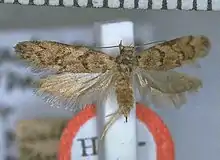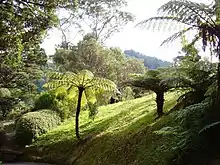| Trachypepla spartodeta | |
|---|---|
 | |
| Female holotype | |
| Scientific classification | |
| Domain: | Eukaryota |
| Kingdom: | Animalia |
| Phylum: | Arthropoda |
| Class: | Insecta |
| Order: | Lepidoptera |
| Family: | Oecophoridae |
| Genus: | Trachypepla |
| Species: | T. spartodeta |
| Binomial name | |
| Trachypepla spartodeta | |
Trachypepla spartodeta is a moth of the family Oecophoridae first described by Edward Meyrick in 1883.[1] It is endemic to New Zealand and has been collected in both the North and South Islands. This species inhabits native forest and adults are on the wing from November to January.
Taxonomy
This species was first described by Edward Meyrick in 1883 using a specimen collected in Wellington in January.[2][3] A fuller description of this species was given by Meyrick in 1884.[3] George Hudson discussed and illustrated this species in his 1928 book The butterflies and moths of New Zealand.[4] The female holotype, collected in the Wellington Botanic Garden, is held at the Natural History Museum, London.[5]
Description
.jpg.webp)
Meyrick described this species as follows:
Female. — 15 mm. Head and palpi pale greyish-ochreous, terminal joint of palpi with two obscure dark fuscous rings, second joint obscurely banded with dark fuscous. Antennae fuscous. Thorax pale greyish-ochreous, mixed with dark fuscous. Abdomen grey. Anterior and middle legs dark fuscous, with pale greyish-ochreous rings at apex of joints ; posterior legs whitish-ochreous, slightly infuscated. Forewings elongate, rather narrow, costa moderately arched, apex nearly pointed, hindmargin hardly rounded, very oblique ; greyish-ochreous, somewhat mixed with dark fuscous ; markings cloudy dark fuscous ; a small spot at base of costa, and another on inner margin near base ; a transverse line from 1⁄4 of costa to 1⁄3 of inner margin, forming a right angle outwards in disc, where it is mixed with ferruginous, and preceded near inner margin by a tuft of raised scales ; a narrow elongate spot along central third of costa, connected with a raised ferruginous spot in middle of disc, beneath which is a raised tuft and some irregular dark fuscous spots ; a transverse line proceeding from costa at 4⁄5 obliquely inwards, a little beneath costa sharply bent outwards, and thence curved to anal angle; three or four small cloudy marginal spots round apex: cilia pale greyish-ochreous, mixed with dark fuscous. Hindwings pale grey, apex and hindmargin darker ; cilia grey- whitish, with two faint grey lines.[3]
This species is variable in the intensity and depth of its general colouration as well as in the markings on its forewings.[4]
Distribution

This species is endemic to New Zealand and has been collected in Wellington as well as in Taupo, Dunedin and Southland.[6][7] Hudson was of the opinion that this species was rather rare.[4]
Habitat
This species inhabits native forest.[4]
Behaviour
The adults of this species are on wing from November until January.[8]
References
- 1 2 Gordon, Dennis P., ed. (2010). New Zealand inventory of biodiversity: Kingdom animalia : chaetognatha, ecdysozoa, ichnofossils. Vol. 2. p. 462. ISBN 978-1-877257-93-3. OCLC 973607714. OL 25288394M. Wikidata Q45922947.
- ↑ Edward Meyrick (September 1883). "Descriptions of New Zealand Micro-Lepidoptera.—III.—Oecophoridae". New Zealand Journal of Science. 1: 522. Wikidata Q106368126.
- 1 2 3 Edward Meyrick (1884). "Descriptions of New Zealand Microlepidoptera. III. Oecophoridae". Transactions and Proceedings of the New Zealand Institute. 16: 16. ISSN 1176-6158. Wikidata Q63976486.
- 1 2 3 4 George Vernon Hudson (1928), The butterflies and moths of New Zealand, Illustrator: George Hudson, Wellington: Ferguson and Osborn Limited, p. 285, LCCN 88133764, OCLC 25449322, Wikidata Q58593286
- ↑ John Stewart Dugdale (23 September 1988). "Lepidoptera - annotated catalogue, and keys to family-group taxa". Fauna of New Zealand. Department of Scientific and Industrial Research. 14: 107. doi:10.7931/J2/FNZ.14. ISSN 0111-5383. Wikidata Q45083134.
- ↑ "Trachypepla spartodeta Meyrick, 1883". www.nzor.org.nz. Retrieved 2022-05-03.
- ↑ "Trachypepla spartodeta". www.aucklandmuseum.com. 2022. Retrieved 30 July 2022.
- ↑ "Trachypepla spartodeta Meyrick, 1884". www.gbif.org. Retrieved 2022-07-29.